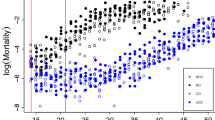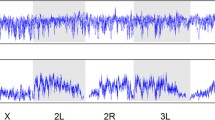Abstract
Five populations of Drosophila melanogaster that had been selected for postponed aging were compared with five control populations using two-dimensional protein gel electrophoresis. The goals of the study were to identify specific proteins associated with postponed aging and to survey the population genetics of the response to selection. A total of 321 proteins were resolvable per population; these proteins were scored according to their intensity. The resulting data were analyzed using resampling, combinatoric, and maximum parsimony methods. The analysis indicated that the populations with postponed aging were different from their controls with respect to specific proteins and with respect to the variation between populations. The populations selected for postponed aging were more heterogeneous between populations than were the control populations. Maximum parsimony trees separate the selected populations, as a group, from their controls, thereby exhibiting a homoplastic pattern.
Access this chapter
Tax calculation will be finalised at checkout
Purchases are for personal use only
Preview
Unable to display preview. Download preview PDF.
Similar content being viewed by others
References
Anderson, N. G. & N. L. Anderson, 1978. Analytical techniques for cell fractions. XXI. Two-dimensional analysis of serum and tissue proteins: multiple isoelectric focusing. Anal. Biochem. 85: 331–340.
Aquadro, C. F. & J. C. Avise, 1981. Genetic divergence between rodent species assessed by using two-dimensional electrophoresis. Proc. Natl. Acad. Sci. 78: 3784–3788.
Bozcuk, A. N., 1981. Genetic longevity in Drosophila. V. The specific and hybridized effect of rolled, sepia, ebony and eyeless autosomal mutants. Exp. Gerontol. 11: 103–112.
Clare, M. J. & L. S. Luckinbill, 1985. The effects of gene-environment interaction on the expression of longevity. Heredity 55: 19–29.
Dice, L. R., 1941. Measures of the amount of ecologic association between species. Ecology 26: 297–302.
Felsenstein, J., 1985. Confidence limits on phylogenies: an approach using the bootstrap. Evolution 39: 783–791.
Fleming, J. E., P. S. Melnikoff & K. G. Bensch, 1984. Identification of mitochondrial proteins on two-dimensional electrophoresis gels of extracts of adult Drosophila melanogaster. Biochim. Biophys. Acta 802: 340–345.
Fleming, J. E., E. Quaottrocki, G. Latter, J. Miguel, R. Marcuson, E. Zuckerkandl & K. G. Bensch, 1986. Age-dependent changes in proteins of Drosophila melanogaster. Science 231: 1157–1159.
Fleming, J. E., J. K. Walton, R. Dubitsky & K. G. Bensch, 1988. Aging results in an unusual expression of Drosophila heat shock proteins. Proc. Nat. Acad. Sci. USA 85: 4099–4103.
Garrels, J., 1979. Two-dimensional gel electrophoresis and computer analysis of proteins synthesized by clonal cell lines. J. Biol. Chem. 254: 7961–7977.
Hendy, M. D. & D. Penny, 1982. Branch and bound algorithms to determine minimal evolutionary trees. Math. Biosci. 59: 277–290.
Hutchinson, E. W. & M. R. Rose, 1987. Genetics of aging in insects. Rev. Biol. Res. Aging 3: 62–70.
Hutchinson, E. W. & M. R. Rose, 1990. Quantitative genetic analysis of postponed aging in Drosophila melanogaster, p. 66–87 in Genetic effects on aging II, edited by D. A. Harrison. Telford, Caldwell, N.J.
Hutchinson, E. W. & M. R. Rose, 1991. Quantitative genetics of postponed aging in Drosophila melanogaster. I. Analysis of outbred populations. Genetics 127: 719–727.
Ives, P. T., 1970. Further studies of the South Amherst popula- tion of Drosophila melanogaster. Evolution 24: 507–518.
Johnson, T. E., 1987. Aging can be genetically dissected into conponent processes using long-lived lines of Caenorhabditis elegans. Proc. Natl. Acad. Sci. USA 84: 3777–3781.
Johnson, T. E. & E. W. Hutchinson, 1990. Aging in Caenorhabditis elegans: Update 1988. Rev. Biol. Res. Aging 4: 15–27.
Luckinbill, L. S., M. J. Clare, W. L. Krell, W. C. Cirocco & S. A. Buck, 1987. Estimating the number of genetic elements that defer senescence in Drosophila melanogaster. Evolution 38: 996–1003.
Luckinbill, L. S., T. A. Grudzien, S. Rhine & G. Weisman, 1989. The genetic basis of adaptation to selection for longevity in Drosophila melanogaster. Evol. Ecology 3: 31–39.
Luckinbill, L. S., J. L. Graves, A. H. Reed & S. Koetsawang, 1988a. Localizing the genes that defer senescence in Drosophila. Heredity 60: 367–374.
Luckinbill, L. S., J. L. Graves, A. Tomkiw & O. Sowirka, 1988b. A qualitative analysis of some life-history correlates of longevity in Drosophila melanogaster. Evol. Ecol. 2: 85–94.
Maynard Smith, J., 1966. Theories of aging, p. 1–35 in Topics in the biology of aging, edited by P. L. Krohn. Interscience, New York.
Margush, T. & F. R. McMorris, 1981. Consensus n-trees. Bull. Math. Biol. 43: 239–244.
Nei, M., 1972. Genetic distances between populations. Am. Nat. 106: 283–292.
O’Farrell, P. H., 1975. High resolution two-dimensional electrophoresis of proteins. J. Biol. Chem. 250: 4007–4021.
Ohnishi, S., M. Kawanishi & T. I. Watanabe, 1983. Biochemie phylogenies of Drosophila: protein differences detected by two-dimensional electrohoresis. Genetica 61: 55–63.
Parker, J., J. Flanagan, J. Murphy & J. Gallant, 1981. On the accuracy of protein synthesis in Drosophila melanogaster. Mech. Age. Dev. 16: 127–139.
Rohlf, F. J., 1990. NTSYS-pc. Numerical taxonomy and multivariate analysis system (ver. 1. 60 ). Exeter Pub., Setauket, New York.
Rose, M. R., 1984. Laboratory evolution of postponed senescence in Drosophila melanogaster. Evolution 38: 1004–1010.
Rose, M. R., 1989. Genetics of increased lifespan in Drosophila. Bioessays 11: 132–135.
Rose, M. R., 1991. Evolutionary biology of aging. Oxford University Press, New York.
Rose, M. R. & B. Charlesworth, 1981. Genetics of life-history in Drosophila melanogaster. II. Exploratory selection experiments. Genetics 97: 187–196.
Rose, M. R., M. L. Dorey, A. M. Coyle & P. M. Service, 1984. The morphology of postponed senescence in Drosophila melanogaster. Can. J. Zool. 62: 1576–1580.
Sanderson, M. J., 1989. Confidence limits on phylogenies: the bootstrap revisited. Cladistics 5: 113–129.
Service, P. M., E. W. Hutchinson, M. D. MacKinley & M. R. Rose, 1985. Resistance to environmental stress in Drosophila melanogaster selected for postponed senescence. Physiol. Zool. 58: 380–389.
Service, P. M., 1987. Physiological mechanisms of increased stress resistance in Drosophila melanogaster selected for postponed senescence. Physiol. Zool. 60: 321–326.
Sneath, P. H. A. & R. R. Sokal, 1973. Numerical taxonomy. W. H. Freeman and Co., San Francisco.
Sokal R. R. & P. H. A. Sneath, 1963. Principles of numerical taxonomy. W. H. Freeman and Co., San Francisco.
Swofford, D. L., 1990. PAUP. Phylogenetic analysis using parsimony (ver. 3. On). Ill. Nat. Hist. Surv., Champaign, Illinois.
Swofford, D. L. & W. P. Maddison, 1987. Reconstructing ancestral character states under wagner parsimony. Math. Biosci. 87: 199–229.
Author information
Authors and Affiliations
Editor information
Editors and Affiliations
Rights and permissions
Copyright information
© 1994 Springer Science+Business Media Dordrecht
About this chapter
Cite this chapter
Fleming, J.E., Spicer, G.S., Garrison, R.C., Rose, M.R. (1994). Two-dimensional protein electrophoretic analysis of postponed aging in Drosophila . In: Rose, M.R., Finch, C.E. (eds) Genetics and Evolution of Aging. Contemporary Issues in Genetics and Evolution, vol 3. Springer, Dordrecht. https://doi.org/10.1007/978-94-017-1671-0_17
Download citation
DOI: https://doi.org/10.1007/978-94-017-1671-0_17
Publisher Name: Springer, Dordrecht
Print ISBN: 978-90-481-4416-7
Online ISBN: 978-94-017-1671-0
eBook Packages: Springer Book Archive




